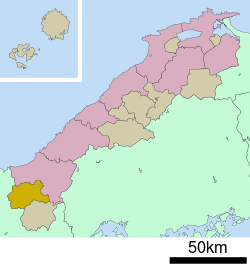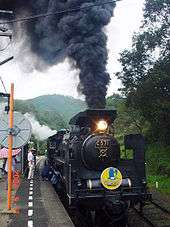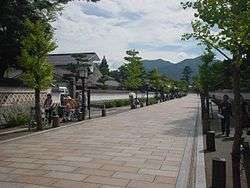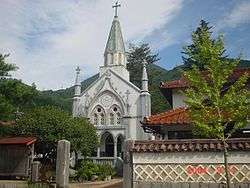Tsuwano, Shimane
| Tsuwano 津和野町 | ||
|---|---|---|
| Town | ||
| ||
 Location of Tsuwano in Shimane Prefecture | ||
 Tsuwano Location in Japan | ||
| Coordinates: 34°28′N 131°46′E / 34.467°N 131.767°ECoordinates: 34°28′N 131°46′E / 34.467°N 131.767°E | ||
| Country | Japan | |
| Region |
Chūgoku San'in | |
| Prefecture | Shimane Prefecture | |
| District | Kanoashi | |
| Government | ||
| • Mayor | Hiroyuki Shitamori | |
| Area | ||
| • Total | 307.09 km2 (118.57 sq mi) | |
| Population (January 2008) | ||
| • Total | 9,014 | |
| • Density | 29.4/km2 (76/sq mi) | |
| Symbols | ||
| • Tree | Camphor Laurel | |
| • Flower | Farfugium japonicum | |
| • Bird | Ural owl | |
| Time zone | Japan Standard Time (UTC+9) | |
| City hall address |
54-25 Nichihara, Tsuwano-chō, Kanoashi-gun, Shimane-ken 699-5292 | |
| Website |
www | |
Tsuwano (津和野町 Tsuwano-chō) is a town located in Kanoashi District, Shimane Prefecture, Japan.
As of May 2015, the town has an estimated population of 7,684 and a density of 25.0 persons per km². The total area is 307.09 km².
Tsuwano is remotely located and surrounded by hills. Though geographically closer to Yamaguchi, the capital of Yamaguchi Prefecture, it is situated in Shimane Prefecture. A train trip to Matsue, Shimane’s capital, takes as long as four hours. Due to its proximity to the border to neighboring Yamaguchi, many tourists who come to Tsuwano also visit Hagi on the Sea of Japan and Yamaguchi at the same time, and Tsuwano is often mistaken as being located in Yamaguchi prefecture for this reason.
Popularly called the "Little Kyoto of San-In," Tsuwano is known for its picturesque mainstreet, "Tono-machi," which is lined with Edo-era buildings and Koi ponds. It also boasts one of the oldest still in use "Yabusame" (horse back archery) ranges in all of Japan, and its annual Yabusame festival on the second Sunday of April is a large tourist draw for the San-In region.
On September 25, 2005 the town of Nichihara was merged into Tsuwano.
Tsuwano is somewhat unusually home to two Catholic churches. The Catholic church in Tsuwano itself is dedicated to Saint Francis Xavier, who visited Japan as a missionary in 1549–50, and is located on its mainstreet. The Santa Maria Church at Otome Pass was dedicated in 1951 and is part of a memorial for Japanese Christians persecuted and tortured in Tsuwano by the government during the Edo and Meiji periods.
Other notable locations and tourist attractions within Tsuwano include the ruins of Tsuwano Castle, where the Kamei clan once ruled the Tsuwano fiefdom from the 17th through mid 19th-centuries, and the famed mountainside Taikodani Inari Shrine with its "1000 vermillion torii gates." In 1773 Tsuwano's seventh generation feudal lord Kamei Norisada had Taikodani Inari built to enshrine a share of the spirit worshipped at the Fushimi Inari in Kyoto. This shrine was built to pray for the safety of Kamei's castle and peace among his people. As one of five Inari shrines in Japan, it attracts people from throughout western Japan to pray for prosperity and good fortune in the coming year.
Notable people
Novelist Mori Ōgai was born in Tsuwano into a family of doctors, and the house of his birth is preserved. Mori studied medicine in Germany and led the adoption of German medical practices into the Japanese military. In commemoration, Tsuwano became a sister city of Berlin's central ward under an agreement signed August 25, 1995. His tomb is located in Yomei-ji Temple in Tsuwano, which was built in 1420 and is known as one of two great Sōtō sect temples, the other being Daijo-ji Temple in Kanazawa city.
Philosopher Nishi Amane, another leader of Japan’s modernization in the Meiji period, was also born in Tsuwano. His ancestors were physicians for the daimyo of the fief.
Tsuwano has two new art galleries to celebrate artistic sons. One, the Anno Art Museum (opened in 2001), is dedicated to Mitsumasa Anno, who was born and raised in Tsuwano. The other is the Shisei Kuwabara Photographics Museum, the name since April 1, 2004 of what was previously the Tsuwano Documentary Photograph Gallery; this features photographs by and is named after Shisei Kuwabara, famous for his work in Minamata and Korea.
Rie Fujii (b. 1971) is also from Tsuwano. In 2001, Fujii abandoned her two infant children in their apartment in Calgary, Alberta. She returned to the apartment after ten days, at which time she found both infants had died of starvation and/or dehydration. Fujii was convicted of manslaughter in a Canadian court, and served five years of an eight-year sentence, after which she was deported to Japan.
Yamaguchi-gō steam locomotive

A popular tourist destination, Tsuwano is served by the steam locomotive Yamaguchi-gō, which runs once daily on weekends, national holidays, and certain other days between March and November (daily in August) on the Yamaguchi Line from Shin-Yamaguchi Station to Tsuwano and back.[1] It stops for about three hours in Tsuwano before returning to Shin-Yamaguchi station. The train is usually pulled by a C57 locomotive, but a C56 does the job on several weekdays between July and September, and both engines are linked in a double-header configuration on weekends in August. Carriages are decorated in the styles of three Japanese eras—Meiji, Taisho, and Showa—as well as in European style, and the rear-most carriage has an outdoor observation deck.
A scene in director Masahiro Shinoda’s Spy Sorge, a 2003 movie about Soviet spy Richard Sorge, was shot on the train for period effect.
References
External links
 Media related to Tsuwano, Shimane at Wikimedia Commons
Media related to Tsuwano, Shimane at Wikimedia Commons-
 Tsuwano travel guide from Wikivoyage
Tsuwano travel guide from Wikivoyage - Official website (Japanese)


